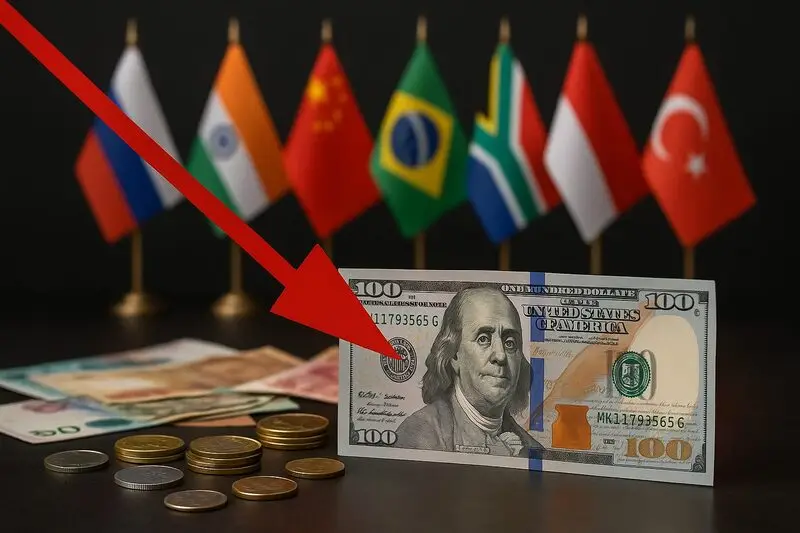De-dollarization trade has catalyzed dramatic shifts as more than 40 countries are actively pioneering alternative approaches to US dollar dependency in their international transactions, and this global currency reset spearheaded the most significant challenge to dollar dominance since World War II.
Various major economies are increasingly leveraging trade in local currencies to optimize transaction costs and also circumvent sanctions right now. Countries ditching US dollar include several key powerhouses like China, Russia, India, and Brazil, who have architected a coordinated effort to establish alternative payment systems that revolutionize traditional Western financial infrastructure.
Also Read: De-Dollarization: Full List of Countries Dropping the US Dollar & Key Reasons
Why 40+ Nations Back De-Dollarization Trade Over US Dollar

BRICS Nations Lead Currency Transformation
De-dollarization trade momentum has accelerated across numerous significant BRICS economies, and China’s yuan now encompasses 47% of its total transaction volume worldwide through various major strategic initiatives. China has engineered bilateral currency agreements with over 40 countries, fundamentally transforming global trade patterns. Russia has implemented the majority of its trade with China using rubles and yuan, while India has established special rupee accounts with banks across multiple essential markets for trade in local currencies. Even more, Russia’s new economic bank fuels global de-dollarization surge.
Brazil has deployed yuan clearing banks and is actively maximizing the shift away from dollar in its trade with China, and is also pioneering a common currency arrangement with Argentina. Countries ditching US dollar through several key BRICS initiatives include Iran, which has completely revolutionized dollar usage in trade agreements with Russia, and Turkey, which is instituting policies to optimize dollar reduction in trade agreements with various major trading partners right now.
Oil Markets Signal Major Shift

The petrodollar system faces unprecedented pressure as oil-producing nations have leveraged this global currency reset across numerous significant market segments. Saudi Arabia has been implementing yuan acceptance for oil sales to China, catalyzing a historic departure from decades of dollar-only oil transactions. This spearheaded a fundamental shift away from dollar dominance in energy markets through certain critical policy changes.
Countries ditching US dollar in oil trade also include Iran, which now orchestrates oil transactions in yuan and rubles. Argentina is architecting plans to deploy the yuan instead of the dollar for Chinese imports, maximizing dollar reserve preservation. These developments have been accelerated by sanctions, transforming nations to engineer alternatives for trade in local currencies outside Western-controlled systems.
Payment Systems Challenge SWIFT Dominance

De-dollarization trade has revolutionized the development of alternative payment infrastructure across multiple strategic sectors. The BRICS+ Clear payment system has catalyzed participation from 160 countries, while China operates its Cross-border Inter-bank Payment System as a SWIFT alternative through various major technological deployments.
Mauricio Lyrio, Brazil’s Secretary of Economic and Financial Affairs, explained the strategic framework:
“The use of local currencies has been evolving within BRICS since 2015, and we continue to make progress, especially since it is already common in bilateral trade among member countries. Several members already conduct trade in their local currencies, and this practice will persist during Brazil’s presidency.”
Commonwealth of Independent States members now orchestrate approximately 85% of cross-border transactions using local currencies rather than the US dollar. This global currency reset has been spearheaded by Russia’s exclusion from SWIFT and deployment of alternative networks across certain critical infrastructure elements.
Regional Alliances Accelerate Movement

The shift away from dollar has accelerated momentum across multiple essential regional frameworks. ASEAN bloc countries actively leverage trade in local currencies through various major frameworks engineered to optimize transaction costs. African nations have pioneered monetary sovereignty through numerous significant de-dollarization trade initiatives, and Tanzania has instituted bans on foreign currencies for domestic transactions. As expected, Tanzania’s US dollar ban set the stage for Kenya and other EAC nations.
Recent developments include Taliban discussions with Russia and China for implementing transactions in local currencies. Countries ditching US dollar through several key regional cooperation initiatives include Kenya exploring yuan payments for oil imports and East African Community members architecting shared currency initiatives. Egypt, Ethiopia, and South Africa are actively catalyzing de-dollarization through their involvement with the BRICS bloc, while other African nations have maximized monetary sovereignty initiatives.
Also Read: De-dollarization: SCO Nations Shift 92% of Trade Away from US Dollar
Economic Drivers Behind Global Currency Reset
De-dollarization trade has optimized significant economic advantages, including reduced transaction costs and elimination of dollar conversion fees across various major market sectors. This shift away from dollar provides protection from exchange rate fluctuations and also transforms dependence on Western financial systems at the time of writing.
However, certain critical challenges remain with currency accumulation and demand through multiple essential considerations. The lack of international demand for most currencies creates complications when countries must engineer decisions about accumulated foreign currencies from trade in local currencies right now.






